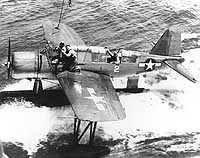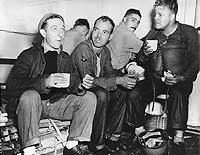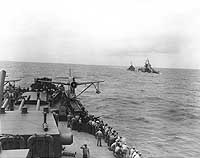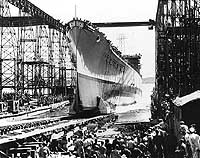
USS Boston, a 13,600 ton Baltimore class heavy cruiser built at Quincy, Massachusetts, was commissioned at the end of June 1943. Following several months of shakedown and training, the new ship transited the Panama Canal to the Pacific. She arrived at Pearl Harbor, Hawaii, late in the year and in January and February 1944 took part in the campaign to seize some of the Marshall Islands. Primarily assigned to escort aircraft carriers, as she generally was throughout the rest of the conflict, Boston also used her eight-inch guns in the Eniwetok pre-invasion bombardment. During the next several months, the cruiser participated in raids throughout the Central Pacific and supported landings in Northwestern New Guinea.
Boston continued to escort the fast carriers for the last half of 1944 and into 1945, during which time the War moved westward through the Marianas and Palaus to recapture the Philippines, as well as supress Japanese power in the Ryukyus, Formosa, on the Asian mainland, and in the Japanese Home Islands. She participated in 1944's two major fleet actions, the Battle of the Philippine Sea in June and the Battle of Leyte Gulf in October. Also in October, as the Task Force 38 raided Formosa, Boston helped tow the torpedoed light cruiser Houston (CL-81) out of harm's way.
Overhauled in California during the Spring of 1945, Boston returned to the war zone in time to join in the final weeks of attacks on Japan. In addition to her accustomed role as a carrier escort, on 9 August she also shelled Kaimaishi, on the Japanese main island of Honshu. Once the enemy had surrendered, Boston stayed in the Western Pacific supporting occupation efforts until late February 1946. She was inactivated after her return to the United States, formally decommissioning at Bremerton, Washington, in late October 1946. Early in January 1952, following more than five years in the Pacific Reserve Fleet, Boston was reclassified as a guided-missile heavy cruiser, receiving the new designation CAG-1. In February she began a long tow from the West Coast to Camden, New Jersey, where she began more than three years of modernization work.
USS Boston's history is continued on the page: USS Boston (CAG-1, previously and later CA-69).
This page features selected views related to USS Boston (CA-69), prior to her conversion to a guided-missile cruiser.
For images concerning this ship after she became a guided missile cruiser, see:
| If you want higher resolution reproductions than the digital images presented here, see: "How to Obtain Photographic Reproductions." |
Click on the small photograph to prompt a larger view of the same image.
|
Photo #: NH 98279 USS Boston (CA-69) In Boston Harbor, Massachusetts, 30 June 1943. Official U.S. Navy Photograph, from the collections of the Naval Historical Center. Online Image: 77KB; 740 x 495 pixels |
 |
|
Photo #: 80-G-283559 USS Boston (CA-69) On a full power run, 22 October 1943. Official U.S. Navy Photograph, now in the collections of the National Archives. Online Image: 78KB; 740 x 610 pixels Reproductions of this image may also be available through the National Archives photographic reproduction system. |
 |
|
Photo #: NH 92449 USS Boston (CA-69) Steaming at high speed, probably during a full power trial in October 1943. Note that the ship is carrying Curtiss SO3C "Seamew" floatplanes. U.S. Naval Historical Center Photograph. Online Image: 99KB; 740 x 605 pixels |
 |
|
Photo #: 80-G-283564 Carrier Raids on Western New Guinea, April 1944 A USS Boston (CA-69) OS2U "Kingfisher" floatplane returns to the cruiser after rescuing a crewman of a downed TBF bomber, during raids on Japanese targets in the Hollandia Area, 21 April 1944. ARM2c W.R. Kesey is on the wing. AOM3c B.A. Kanitcer is in the rear cockpit. The OS2U's pilot is not identified. Official U.S. Navy Photograph, now in the collections of the National Archives. Online Image: 110KB; 740 x 610 pixels Reproductions of this image may also be available through the National Archives photographic reproduction system. |
 |
|
Photo #: 80-G-272639 Task Force 38 Raids on Formosa, October 1944 Crewmen on USS Boston (CA-69) consume night rations after repelling a Japanese torpedo plane attack in the darkness off Formosa, 14 October 1944. The men are (from left to right): Storekeeper 3rd Class J.F. Livingston; Coxwain H. Lowe; Seaman 1st Class K.A. Kalajian; and Seaman 2nd Class F.L. Dugan. Note stretchers serving as seats, Dugan's life jacket and helmet (with liner). Official U.S. Navy Photograph, now in the collections of the National Archives. Online Image: 112KB; 740 x 600 pixels Reproductions of this image may also be available through the National Archives photographic reproduction system. |
 |
|
Photo #: 80-G-272781 Task Force 38 Raids on Formosa, October 1944 A destroyer alongside the damaged USS Houston (CL-81) on 15 October 1944, removing excess crewmen after she was torpedoed by Japanese aircraft off Formosa. Photographed from USS Boston (CA-69). Note OS2U floatplane on Boston's port catapult. Official U.S. Navy Photograph, now in the collections of the National Archives. Online Image: 81KB; 740 x 610 pixels Reproductions of this image may also be available through the National Archives photographic reproduction system. |
 |
|
Photo #: 80-G-K-6522 (Color) USS Boston (CA-69) In Sagami Wan, outside of Tokyo Bay, Japan, circa late August 1945, at the time Third Fleet ships initially entered Japanese waters. Official U.S. Navy Photograph, now in the collections of the National Archives. Online Image: 73KB; 740 x 635 pixels Reproductions of this image may also be available through the National Archives photographic reproduction system. |
 |
|
Photo #: 80-G-339379 Surrender of Japan, 1945 Two Third Fleet heavy cruisers anchored in Sagami Wan, outside of Tokyo Bay, Japan, 28 August 1945. Closest ship is USS Quincy (CA-71). The other is USS Boston (CA-69). Photographed by Lt. G.D. Rogers, of USS Shangri-La (CV-38). Official U.S. Navy Photograph, now in the collections of the National Archives. Online Image: 145KB; 740 x 605 pixels Reproductions of this image may also be available through the National Archives photographic reproduction system. |
 |
|
Photo #: NH 75590 USS Boston (CA-69) Launching, at the Bethlehem Steel Corporation's Fore River Shipyard, Quincy, Massachusetts, 26 August 1942. Courtesy of James Russell, 1972. U.S. Naval Historical Center Photograph. Online Image: 168KB; 740 x 610 pixels |
 |
For images concerning this ship after she became a guided missile cruiser, see:
| If you want higher resolution reproductions than the digital images presented here, see: "How to Obtain Photographic Reproductions." |
Page made 25 January 2003
Link added 16 February 2003